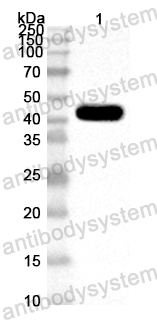Catalog No.
PMN53301
Species reactivity
Mouse
Host species
Rabbit
Isotype
IgG
Clonality
Polyclonal
Immunogen
E. coli - derived recombinant Mouse TAPBPL (Gln33-Pro406).
Tested applications
ELISA: 1:4000-1:8000, IHC: 1:50-1:100, WB: 1:1000-1:4000
Target
Tapasin-related protein, TAPASIN-R, TAP-binding protein-like, TAP-binding protein-related protein, TAPBP-R, Tapasin-like, Tapbpl
Purification
Purified by antigen affinity column.
Accession
Q8VD31
Applications
ELISA, IHC, WB
Form
Liquid
Storage buffer
0.01M PBS, pH 7.4, 50% Glycerol, 0.05% Proclin 300.
Stability and Storage
Use a manual defrost freezer and avoid repeated freeze thaw cycles. Store at 2 to 8°C for frequent use. Store at -20 to -80°C for twelve months from the date of receipt.
CryoEM structure of an MHC-I/TAPBPR peptide-bound intermediate reveals the mechanism of antigen proofreading., PMID:39786927
Administration of Recombinant TAPBPL Protein Ameliorates Collagen-Induced Arthritis in Mice., PMID:37762076
The ER folding sensor UGGT1 acts on TAPBPR-chaperoned peptide-free MHC I., PMID:37345806
Get into the groove! The influence of TAPBPR on cargo selection., PMID:37295041
Combination of Immune-Related Network and Molecular Typing Analysis Defines a Three-Gene Signature for Predicting Prognosis of Triple-Negative Breast Cancer., PMID:36358906
Novel plasma and brain proteins that are implicated in multiple sclerosis., PMID:36346149
The glycosylation status of MHC class I molecules impacts their interactions with TAPBPR., PMID:34543843
The role of MHC I protein dynamics in tapasin and TAPBPR-assisted immunopeptidome editing., PMID:34265495
Exchange catalysis by tapasin exploits conserved and allele-specific features of MHC-I molecules., PMID:34244493
Why TAPBPR? Implications of an additional player in MHC class I peptide presentation., PMID:34052734
TAPBPR promotes antigen loading on MHC-I molecules using a peptide trap., PMID:34039964
Identification of TAPBPL as a novel negative regulator of T-cell function., PMID:33938620
The Ins and Outs of TAPBPR., PMID:32814254
A loop structure allows TAPBPR to exert its dual function as MHC I chaperone and peptide editor., PMID:32167472
Molecular determinants of chaperone interactions on MHC-I for folding and antigen repertoire selection., PMID:31796585
Distinct Polymorphisms in HLA Class I Molecules Govern Their Susceptibility to Peptide Editing by TAPBPR., PMID:31693900
Structural aspects of chaperone-mediated peptide loading in the MHC-I antigen presentation pathway., PMID:31084439
TAPBPR mediates peptide dissociation from MHC class I using a leucine lever., PMID:30484775
Utilizing TAPBPR to promote exogenous peptide loading onto cell surface MHC I molecules., PMID:30213851
Preferential interaction of MHC class I with TAPBPR in the absence of glycosylation., PMID:30077416
Peptide exchange on MHC-I by TAPBPR is driven by a negative allostery release cycle., PMID:29988068
Structure of the TAPBPR-MHC I complex defines the mechanism of peptide loading and editing., PMID:29025996
Crystal structure of a TAPBPR-MHC I complex reveals the mechanism of peptide editing in antigen presentation., PMID:29025991
Properties of the tapasin homologue TAPBPR., PMID:28528220
TAPBPR bridges UDP-glucose:glycoprotein glucosyltransferase 1 onto MHC class I to provide quality control in the antigen presentation pathway., PMID:28425917
Interaction of TAPBPR, a tapasin homolog, with MHC-I molecules promotes peptide editing., PMID:26869717
TAPBPR alters MHC class I peptide presentation by functioning as a peptide exchange catalyst., PMID:26439010
TAPBPR: a new player in the MHC class I presentation pathway., PMID:25720504
TAPBPR isoforms exhibit altered association with MHC class I., PMID:24444341
The binding of TAPBPR and Tapasin to MHC class I is mutually exclusive., PMID:24163410
Tapasin-related protein TAPBPR is an additional component of the MHC class I presentation pathway., PMID:23401559
The splicing factor ASF/SF2 is associated with TIA-1-related/TIA-1-containing ribonucleoproteic complexes and contributes to post-transcriptional repression of gene expression., PMID:20477871
Interaction of tapasin related protein with cell surface MHC class 1 heavy chain molecules., PMID:20112805
A human TAPBP (TAPASIN)-related gene, TAPBP-R., PMID:11920573

